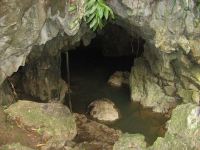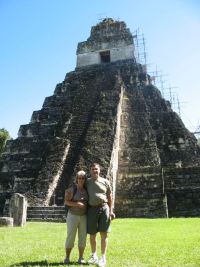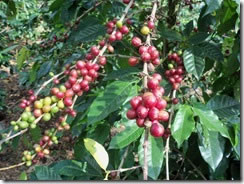Guatamala Spanish By sv Prairie SeaShell on 21 Jan, 2011 7:48 PM Last weekend we went on a whirlwind four day trip to Semuc Champay, the ruins at Tikal, the Rio Dulce and Livingston and a dip in hot sulphur springs at Agua Calientes
Guatemala Spanish School

Guatemala road
Last weekend we went on a whirlwind four day trip to Semuc Champay, the ruins at Tikal, the Rio Dulce and Livingston and a dip in hot sulphur springs at Agua Calientes.
We were travelling on the Pan American Highway which is supposed to be a four lane highway. Unfortunately, there was a severe storm back in August, and many of the roads have not been cleared, so in many places, we were forced to drive in the on-coming lane. A nail biting experience, especially in the dark, in the rain and in the fog!
Our first stop was for supper at Antigua, but since it was already dark, we didn't get to see much. In the middle of the night, our driver stopped at what appeared to be a dead end road.
There was a light coming towards us, which turned out to be a make shift ferry. We had to cross a small river on a flat deck ferry, powered by two Yamaha outboard motors. The trip was made even more interesting as we had to share the deck with a huge tanker truck.
After driving all night, at 5:30 am, we had to vacate our rather cramped mini-bus and pile into a four wheel drive pick up truck for the trek into Semuc Champay. It was an hour and a half trip, down an extremely steep and severly rutted trail.
Luckily the truck was a super cab, and the "old folks" on the trip were able to ride in the relative comfort of the cab. The young folk had to ride, standing up in the box, under a tarp, in the dark, the cold and the rain.

Indiana Jones move over!
Next, we crawled, climbed, swam a kilometer back into this cave, holding a big candle in one hand and swiming with the other. Fortunately we didn't have to battle any bats!
We did however, get to sample this fruit. One of the other students had previously worked in Costa Rica, and he knew how to pick and cut open the cocoa fruit. If the fruit is not picked correctly from the tree, it will not produce next season.
The fruit grows on the trunk of the tree, not up in the leaves. The cocoa beans are under the white fruit, which is a slightly tangy tasting fruit, with a consistancy a little softer than coconut. Quite tasty!
After our caving, we relaxed by the natural pools and listed to the roar of the howler monkeys. For a relatively small monkey, they have a roar as loud as a lion. However, the noise didn't scare off the beautiful blue butterflies, who just wouldn't land anywhere for me to get a picture.
Our last stop for the day was at the Hotel El Muelle (The Dock) on the shores of Lake Peten. Our guide for Tikal, Oliver, met us here for breakfast the next morning and took us through the ruins at Tikal. He was very knowledgeable, not only about the history of the ruins, but also about the plants, animals & flowers of the area. He had worked at some of the excavation sites, and you could tell he loved his job ... it was his life. And ... his English was excellent!

We only had about four hours at the ruins, could have spent four days!
Does this scene look familiar to anyone ? Remember the original Stars Wars Movie (circa 1977)
Our guide warned us about climbing this temple. It's like climbing a ladder about 200 feet straight up.
The archeologists are trying to preserve some of the stella by putting a roof over them to keep the sun and rain off. The limestone is very soft and erodes easily.
Wildlife abounds at Tikal. The wild pig greeted us at the gate, the coatamundi joined us for a snack, and the Toucan watched over us as we left.
Next stop was the Rio Dulce where we took a launcha (aka a panga) under the bridge and up the river, stopping first in Livingston for breakfast, where we felt like we had arrived on a Carribean island. Most of the residents are of African descent and even the language was no longer Spanish, but Garifuna (a Creole dialect). At Aqua Calientes (Warm Waters) we soaked our feet in a very hot sulphur spring while we enjoyed a fresh coconut drink.
And before we returned to town for supper, we circled the Fort (Castillo de San Felipe)
Since then, we have toured the local cemetery on the Day of the Dead to observe their culture and customs.
We visited the Mirador at Cerro Baul where we watched our host family do a little tobogganing … Guatemalan style. What a great view of the city.
Another week is quickly coming to an end, and I’m afraid the Spanish is not much improved! … but the activities continue.

Pupusas, a traditional meal of maseca
This week found us learning to make pupusas, a traditional meal of maseca (corn flour) stuffed with cheese, onion and chicharon (don’t ask what that is) and covered with a picante coleslaw! Although pupusas originated in El Salvador, they are quite common here.
We have also found that many of the typical dishes served in Mexico are also found here, just re-arranged a little differently and called something else … but all just as tasty.
Next we visited a nearby town Salcaja, where they dye and weave the cotton that comes from the coast into the various fabrics for the typical dresses. It’s an extremely labour and time intensive project, taking about 2 1/2 months to produce 150 meters of fabric, each skirt taking 6 meters of fabric.
Just to set up the loom takes 6 weeks, then another 6 weeks to complete the weaving. Not exactly profitable, so to supplement their income, they produce a very tasty Fruit Liquor, and of course they offered samples to us.

Move over Willy Wonka and the Chocolate Factory
Next stop, a Fabrica de Chocolate! Move over Willy Wonka and the Chocolate Factory, here comes Victoria.
After a little history of the chocolate industry in Guatemala, Victoria (the mother of one of the teachers of ICA) gave us a demonstration how the roasted cocoa beans are turned into chocolate.
Here in Guatemala it is customary to melt the chocolate into a drink rather than eat it as a chocolate bar … the reason being … it is very strong, pure chocolate, and it’s cold here at night, you need the hot chocolate to warm you up!
In the photo, Victoria is placing the roasted cocoa beans into the grinder, the beans turn into a very dark, thick liquid, to which she ads sugar and a little cinnamon or vanilla, then puts it through the grinder once again before pouring it into one pound molds.
So many things to do, so little time … our next trip was to a Pottery Co-operative and then a trip thru the market at Totonicipan.
We learned a little about the co-operative, most of the artisans work from their homes, except the head honcho … who is 85 years old.
The Clay is made here, pots are fired the first time for 4 hours, then again with the glass coating for another 6 hours at a temp of 1000 degrees.
Took a micro-bus into Toto, then thru the market. The last market we went to in Momostenango was crowded, but nothing like this one. So many women with babies on back and baskets on heads, extremely hard to move, impossible to shop, unless you are in the market for some Easter colored baby chicks.
It was cold and rainy all day, we stopped for some hot chocolate then headed back to Xela.

trip to a Coffee Plantation
A few days later, a trip to a Coffee Plantation and then on to the beach at Champurrico. Enrique, the director of our school, gave us a quick history of the coffee processes here while we walked thru the trees.
The man in the bin is shoveling raw coffee beans. Hot air is forced up through the floor of the bin to dry the beans.
Next stop, the beach … finally some hot, sunny weather and lunch on the black sand beach.
This is definitely a country of drastic climate change. In Xela, temperatures get down to 0 at night and we are always wearing a sweater or light jacket in the daytime. Here, only 2 1/2 hours away, it’s over 30 degrees.
Our last week in Guatemala was just as busy as all the rest of the weeks. A trip to Zunil in celebration of Santa Catarina, lots of music and dancing, the locals lined up early in order to get a front row view. A huge big market where it appeared wholesalers were loading up truck loads of fruits & veggies.

 Previous: Spanish School in Guatemala
Previous: Spanish School in Guatemala ...
Next: Adios Guatamala ...